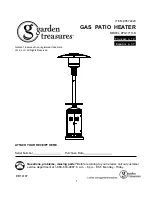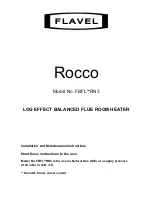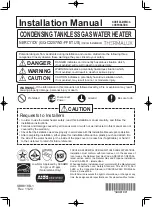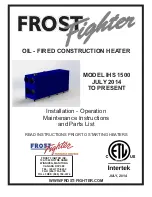
16
DELIMING USING FLO-JUG METHOD
UN•LIME in the 5 gallon size is recommended for deliming of the
BT-80 and 100 models. UN•LIME with the necessary hoses and
fittings to delime your heater is also available as a kit: Up-N-Down
Transfer Kit. Contact your local A.O. Smith dealer, distributor or,
A.O. Smith Water Products Company, Telephone: (800) 433-2545,
Fax: (800) 433-2515 or Website: www.hotwater.com.
Prepare the Water Heater
To delime the water heater using the Flo-Jug method, first prepare
the heater for deliming as described in the "Why? When? and How?"
booklet, Form No. 4800. Then install the long plastic male adapter
fitting into the drain valve opening of the water heater. Use teflon
tape and hand tighten only. Do not overtighten.
Prepare the Up-N-Down Transfer Kit
The next step is the preparation on the Up-N-Down Transfer Kit, if
you have not already done so:
1.
With the 5 gallon Up-N-Down container in the vertical position,
unscrew the plastic vent cap in the handle and pierce the plastic
membrane over the vent boss under the cap to allow the
container to vent.
Note:
If your container does not have the vent cap and vent
boss, drill a 3/16" (4.76mm) hole in the handle. When you have
finished deliming you will be able to plug this drilled vent with
the stainless steel screw that is supplied with the kit.
2.
Remove the container's cap and cut the plastic membrane
located in the 3/4" IPT opening in the cap. Take care to not
damage the threads.
3.
Find the 3/4" male adapter, apply teflon tape to the threaded
end and screw it into the 3/4" IPT opening in the cap.
4.
Put cap with male adapter back on the container and slide 3/4"
hose over end of male adapter and fasten in place using hose
clamp provided.
Delime using Flo-Jug Method
5.
Slide the hose clamp over end of hose and slide hose over the
male adapter in the water heater drain opening and secure in
place using hose clamp.
6.
Lift container to the "Pour" Position, see Figure 9, being careful
to keep the vent in the handle above the liquid level and pour
the UN•LIME into the heater.
7.
Lower container, you may have to place the container on its
empty carton to prevent the UN•LIME from flowing back into the
container.
8.
Let UN•LIME remain in the heater for 5 minutes and then lower
the container to the "Drain" Position, see Figure 9.
9.
Deliming activity is indicated by foaming on the surface of the
UN•LIME. If there is deliming activity, repeat steps 6 thru 8.
Normally, lime removal will be completed within one hour. Severe
build-up of lime may take longer than an hour to complete descaling.
Note: To check UN•LIME for continued use, place some scale or
white chalk in a glass with a small amount of UN•LIME. If the material
is vigorously dissolved by the UN•LIME, it can be reused; if not, the
UN•LIME should be replaced.
CHECKLIST
Before contacting your dealer, check the water heater to see if the
apparent malfunction is caused by some external fault. Consulting
this checklist may eliminate the need for a repair call and restore
hot water service.
NOT ENOUGH OR NO HOT WATER
1.
Check to see if the pilot flame is lit.
•
To relight the pilot, follow the instructions on the heater or in
this manual.
•
Check to see if the main gas shutoff valve in the gas supply
pipe is partially closed or the water temperature dial is set
too low.
2.
Look for leaking or open hot water faucets. Check for excessive
usage.
3.
Your gas company can check the gas input to the heater to see
that it is correct. An underfired heater will not produce hot water
at its normal recovery rate.
4.
If the heater was installed when incoming water temperatures
were warm, colder incoming temperatures will create the effect
of less hot water.
5.
The thermostat water temperature adjusting dial may be set too
low.
6.
If you cannot determine the cause of the problems, contact your
dealer.
WATER TEMPERATURE IS TOO HOT
1.
The thermostat water temperature adjusting dial may be set too
high.
2.
If lowering control setting does not reduce the water temperature
contact your dealer.
GAS SMELL AT THE HEATER
1.
Close the main shutoff valve in the gas supply pipe near the
heater, see fig. 4 on page 7. The thermostat includes a gas
control (top knob) which can also be closed.
2.
Call your gas company.
WATER LEAKAGE IS SUSPECTED
1.
Check to see if the heater drain valve is tightly closed.
2.
The apparent leakage might be condensation. In warm or humid
locations, condensation can accumulate and run from within
the heater or its piping.
•
When a water heater is first installed and filled, the bottom
of the tank might condense water. The water accumulation,





































